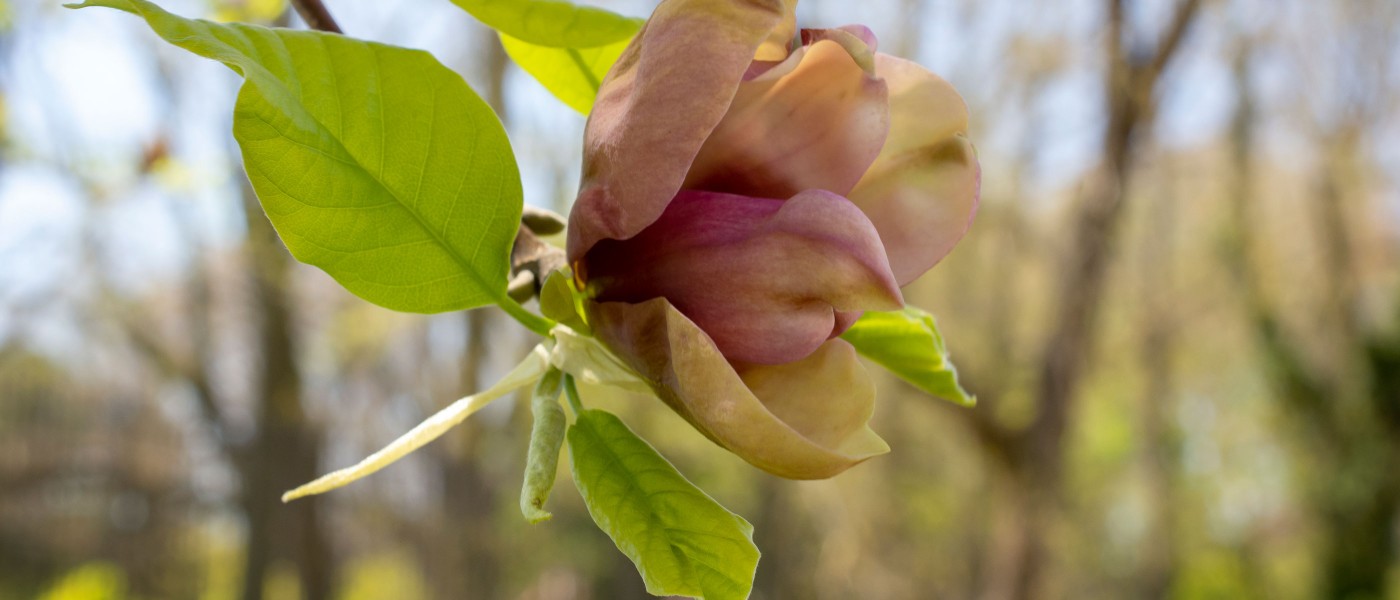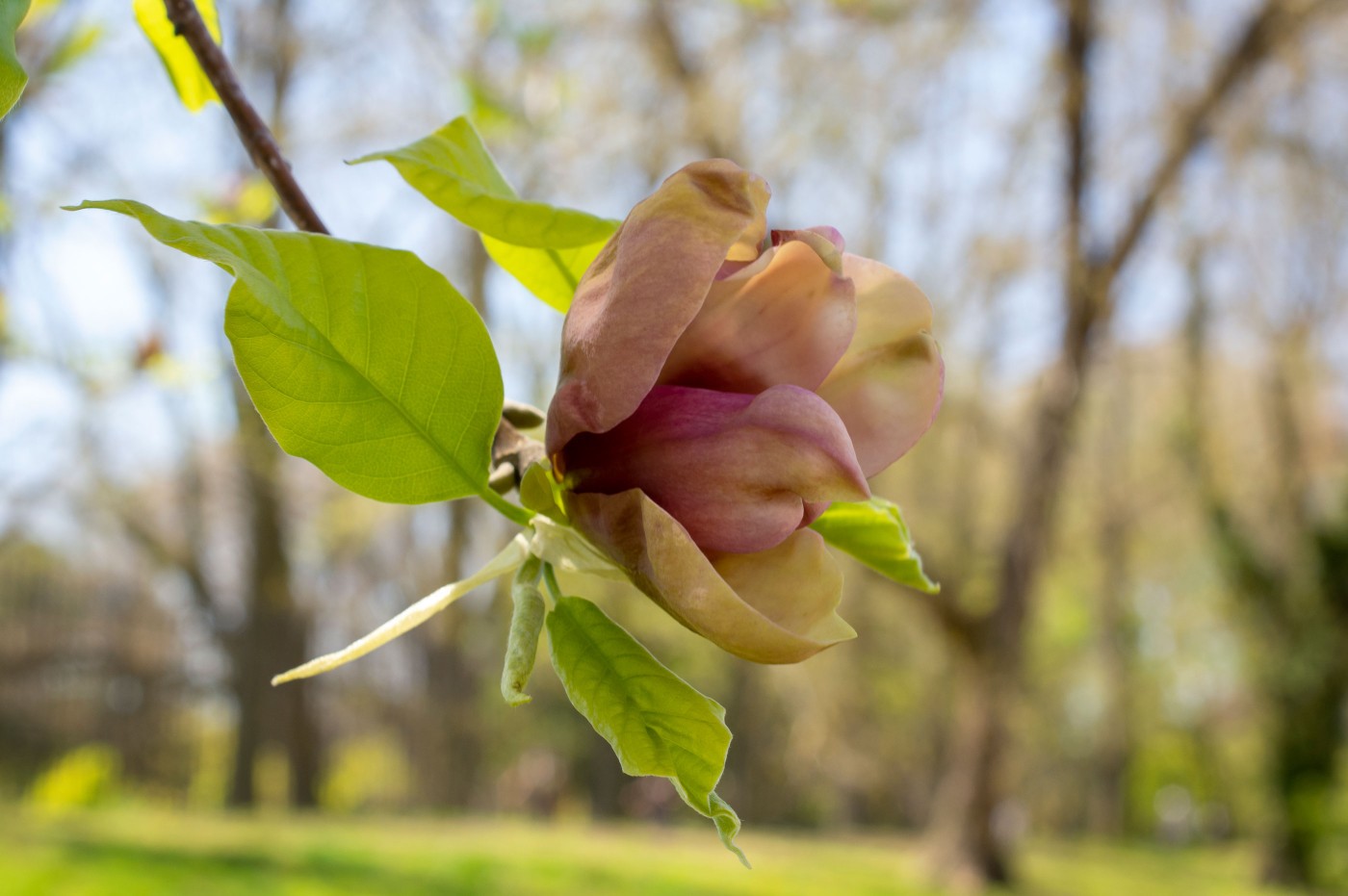Magnolia ‘Evamaria’: Brooklyn Botanic Garden’s First Magnolia Introduction
Magnolia season kicked off in mid March with a slew of species starting to bloom: the yulan magnolia (Magnolia denudata), kobus magnolia (Magnolia kobus), and saucer magnolia (Magnolia × soulangeana), among others. Unfortunately, a few subfreezing nights zapped those blooms—a possibility every year. Luckily, our Brooklyn Botanic Garden magnolia hybrids tend to bloom later than a lot of magnolia species native to East Asia, and other popular hybrids (like the ones noted above), nearly guaranteeing a beautiful show each spring.
One of the least talked about Garden–bred magnolias is one of our most significant. Magnolia × brooklynensis ‘Evamaria’ was the Garden’s first magnolia introduction, patented in 1968. It happens to also be the first successful cross of an Asian magnolia, the mulan magnolia (M. liiliflora ‘Nigra’), with a North American magnolia, the cucumber tree (M. acuminata). Using M. acuminata was a major coup in magnolia breeding. It expanded the range of possible colors with its inherently yellow flower (later done to arguable perfection with Magnolia × ‘Elizabeth’). It also brought ornamental magnolias a level of hardiness not seen before, offering a bit of insurance against late-season frosts.
Magnolia ‘Evamaria’ began at Kitchawan Research Center as “Test Plot #224.” Kitchawan was Brooklyn Botanic Garden’s scientific research and development center, nestled within 223 acres of woodland and meadows in Ossining, New York. One section of Kitchawan was dedicated to magnolia breeding, with a two-acre nursery where over 400 hybrids were planted and trialed. Plant breeder Dr. Evamaria Sperber, a founder of the Garden’s magnolia breeding program, did the hybridization work in 1954.
Hybridizing involves fertilizing a plant (the “seed parent”) with the pollen of another plant (the “pollen parent”). The resultant seeds, hopefully, become the new hybrid plants. The union of Magnolia liliiflora ‘Nigra’ (as pollen parent) and M. acuminata (as seed parent) proved to be fruitful. The hybridized group was named Magnolia × brooklynensis, and the cultivar named ‘Evamaria’ in honor of its hybridizer.
Magnolia ‘Evamaria’ is a small- to medium-sized tree, reaching a mature height of 20 to 25 feet. Its flower is a complex mix of pale purple with hints of yellow, orange, and green. Its later bloom means that it doesn’t bear blossoms before leaves. It has a relatively long bloom period, flowering anywhere from late April to late May or even June once in a blue moon!
Magnolia ‘Evamaria’ was used to develop several other Brooklyn Botanic Garden magnolia hybrids. Magnolia ‘Evamaria’ is a parent to Magnolia × brooklynensis ‘Hattie Carthan’, introduced in 1984. Magnolia × brooklynensis ‘Yellow Bird,’ introduced in 1981, is a backcross of ‘Evamaria’. And Magnolia × brooklynensis ‘Spiced Spumoni’ (an unregistered selection acquired from the Garden’s breeding program after it ceased operations, and named by Klehm’s Song Sparrow Nursery in Wisconsin) also has ‘Evamaria’ in its gene pool. All of these are entirely different stories, with a common thread.
The Garden currently has one ‘Evamaria’ specimen, planted in 1991 directly from Kitchawan Research Center. It’s tucked away on the hill beside the parking lot, facing the Brooklyn Museum—a nondescript locale somewhat fitting for such a subtle beauty. We’re in the process of propagating M. ‘Evamaria’ for planting on Magnolia Plaza in the near future, to give this special tree the recognition and respect it deserves.






